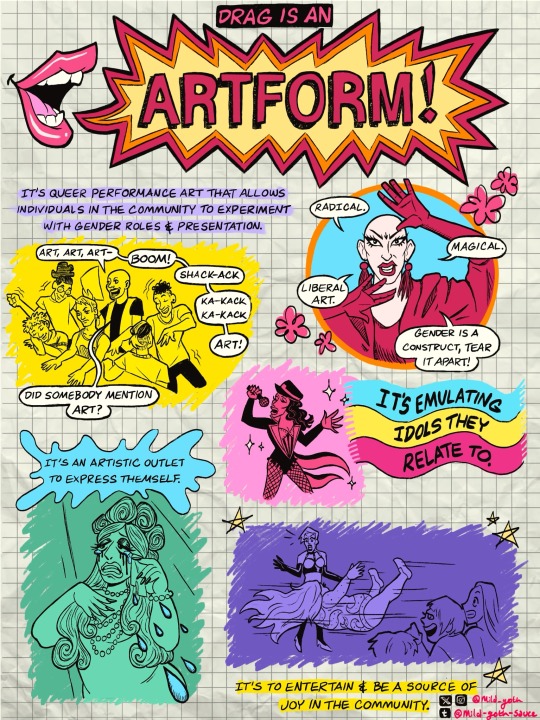#digital eye strain
Explore tagged Tumblr posts
Text
2 notes
·
View notes
Text

$ØM€TH!NG !$ M!$$!NG
Trippcore edit by @stranger2mortals
#nøw !’m nøth!ng#trippcore#trippy aesthetic#trippycore#trippy art#trippy#trippy edit#digital art#modern art#avant garde art#dark art#psychedelic art#weirdcore art#weird art#web art#surrealistic art#weirdcore#w e i r d c o r e#oddcore#my edit#art edit#digital edit#rainbowcore#digital eye strain#psychedelyc art#psychedelic aesthetic#trip art#art#artists on tumblr#pop art
3 notes
·
View notes
Text





An informational comic I drew last year for my Comics 2 class, reposting it to my new account (had to jump ship from the old one unfortunately) with some minor grammar changes and learned my lesson in adding watermarks! Happy early pride :)
#so you think you know drag#drag#drag performer#drag creature#drag artist#drag comic#info comic#infocomic#drag queen#drag king#comic#comic artist#comic art#pop art#divine#my art#artists on tumblr#digital art#digital illustration#lgbtq#lgbtq positivity#lgbtq Art#queer artist#queer art#lgbt pride#queer pride#pride#drag race#eye strain#eye contact
57K notes
·
View notes
Text
0 notes
Text
Understanding Lazy Eye Treatment: Solutions for Adults and Beyond
Lazy eye, also known as amblyopia, is a condition where one eye doesn’t develop properly, causing blurred vision in that eye. It is often diagnosed in childhood, but adults can also experience symptoms and seek treatment. If left untreated, lazy eye can affect depth perception and overall visual function. In this blog, we’ll explore lazy eye treatment, including options for adults, as well as treatments for other common eye conditions like digital eye strain, computer vision syndrome, and squint eye treatment.
Lazy Eye Treatment: Why It’s Important for Adults Too
While many people associate lazy eye treatment with children, adults can also benefit from treatments. Early diagnosis is key, but modern therapies have made it possible to improve vision even in adults. The treatments for lazy eye typically include vision therapy, corrective lenses, or in some cases, surgery. Lazy eye treatment for adults focuses on strengthening the weaker eye and improving visual coordination through various methods like patching the stronger eye, using specialized glasses, or engaging in exercises aimed at improving focus and eye alignment.
Squint Eye Treatment: An Important Part of Eye Health
A squint eye, or strabismus, occurs when the eyes are not aligned properly, leading to difficulty in focusing and sometimes double vision. In many cases, strabismus can accompany lazy eye, and addressing both issues is crucial for restoring optimal vision. Squint eye treatment often involves eye exercises, corrective lenses, and sometimes surgery to realign the eyes. Early intervention is essential, but both children and adults can benefit from squint eye treatment to improve visual coordination and depth perception.
Digital Eye Strain and Its Growing Impact
With the increasing reliance on digital devices, digital eye strain has become a common complaint. Symptoms include headaches, blurry vision, dry eyes, and neck or shoulder discomfort. The condition is caused by prolonged screen use, especially without proper breaks. As we spend more time on computers and smartphones, it’s important to follow strategies to reduce digital eye strain. Simple measures like the 20–20–20 rule, adjusting screen brightness, and maintaining a proper posture can help alleviate discomfort and protect eye health.
Computer Vision Syndrome: A Broader Concern in the Digital Age
Closely related to digital eye strain, computer vision syndrome (CVS) refers to a group of symptoms caused by prolonged use of digital screens. The symptoms are similar to digital eye strain but can be more severe if not addressed. CVS can cause blurred vision, eye fatigue, dry eyes, and difficulty focusing. As with digital eye strain, preventive measures like reducing screen time, adjusting lighting, and taking regular breaks are essential for managing CVS. Additionally, blue light filters on screens and using proper eyewear can help mitigate the effects of prolonged screen exposure.
Treating Lazy Eye, Squint Eye, and Digital Eye Strain: A Comprehensive Approach
Whether you’re dealing with lazy eye, squint eye, or the modern-day challenge of digital eye strain and computer vision syndrome, addressing the root cause is essential. For lazy eye treatment for adults, specialized therapies like vision exercises or corrective lenses may be recommended. Squint eye treatment often requires a multi-faceted approach, combining corrective lenses, exercises, or surgery, depending on the severity of the condition. For digital eye strain and computer vision syndrome, making simple changes to your routine, such as incorporating more breaks and adjusting your screen settings, can provide significant relief.
#lazy eye treatment#lazy eye treatment for adults#Digital eye strain#Computer Vision Syndrome#Squint Eye Treatment
0 notes
Text
Understanding Common Eye Conditions and Their Treatments: A Comprehensive Guide
The human eye is one of the most complex organs in the body, yet it is also highly vulnerable to a range of conditions. From lazy eye treatment and squint eye treatment to managing digital eye strain and Computer Vision Syndrome, this blog explores effective solutions to keep your vision sharp and healthy.
Lazy Eye: What Is It and How Can It Be Treated?
Lazy eye, also known as amblyopia, is a condition where one eye doesn’t develop proper vision during childhood. This can lead to reduced vision in the affected eye. While it is common in children, adults can also benefit from lazy eye treatment for adults.
Treatments for lazy eye include:
Vision therapy: A series of exercises designed to improve coordination between the eyes.
Patching therapy: Covering the stronger eye to encourage the weaker eye to work harder.
Advanced treatments for adults: Techniques such as neuroplasticity-based exercises and virtual reality therapy have shown promise in treating lazy eye for adults.
Timely intervention is crucial, as the untreated lazy eye can lead to lifelong vision problems.
Digital Eye Strain and Computer Vision Syndrome
With increasing screen time, digital eye strain and Computer Vision Syndrome (CVS) have become common issues. Symptoms include:
Eye fatigue
Blurred vision
Headaches
Dry eyes
To manage these conditions:
Follow the 20–20–20 rule: Every 20 minutes, look at something 20 feet away for 20 seconds.
Invest in blue light glasses: These can help reduce the strain caused by digital screens.
Adjust your environment: Proper lighting, an ergonomic screen setup, and frequent breaks can alleviate symptoms.
Ignoring Computer Vision Syndrome can exacerbate eye discomfort and lead to more severe issues, so proactive management is essential.
Squint Eye Treatment: Correcting Misaligned Vision
Squint eye, or strabismus, is a condition where the eyes do not align properly, causing one eye to look in a different direction than the other. This can lead to double vision or poor depth perception.
Effective squint eye treatment options include:
Vision therapy: Exercises to strengthen eye muscles.
Surgery: To correct the alignment of the eye muscles.
Glasses or contact lenses: These can help correct refractive errors contributing to the condition.
If left untreated, squint eye can lead to further complications such as lazy eye.
Holistic Eye Care: A Step Towards Better Vision
Whether you’re dealing with lazy eye treatment, digital eye strain, Computer Vision Syndrome, or squint eye, timely treatment can make a significant difference in maintaining your vision and quality of life. Consult an eye specialist to determine the best treatment plan tailored to your needs.
Taking care of your eyes is not just about correcting vision problems but also about preventing them. Regular eye check-ups and adopting good habits can go a long way in ensuring lifelong eye health.
#lazy eye treatment#lazy eye treatment for adults#Digital eye strain#Computer Vision Syndrome#Squint Eye Treatment
0 notes
Text
Digital Eye Strain? Use Itone Eye Drops for Quick Relief
Relieve digital eye strain with Itone Eye Drops. Soothe tired, dry eyes caused by screens. Natural care for better eye comfort and health. Try Itone now!
#best eye drops for dry eyes india#Itone Eye Drops#eye drops for red eyes#eye drops for irritated eyes#digital eye strain#best eye drops for allergies
0 notes
Text

How To Prevent Common Eye Problems
The Eye: A Vital Organ for Vision
The eye is a complex sensory organ that allows us to perceive the world around us. It functions like a camera, capturing light and converting it into electrical signals that the brain processes into images. This seamless coordination makes vision possible, enabling us to navigate and enjoy life’s beauty.
Why Is the Eye Important for Vision?
The eye is essential for recognizing objects, perceiving colors, and sensing depth. Vision plays a crucial role in learning, communication, and maintaining balance and safety. Without proper eye function, daily tasks become more challenging, emphasizing the importance of eye health.
Parts of the Eye and Their Roles
1. Cornea: The clear, outer layer that focuses light onto the retina.
2. Iris and Pupil: Regulate the amount of light entering the eye.
3. Lens: Adjusts to focus on objects at varying distances.
4. Retina: Contains photoreceptors that convert light into signals.
5. Optic Nerve: Transmits signals from the retina to the brain.
Common Eye Problems
Glaucoma: Increased eye pressure that can damage the optic nerve.Light Sensitivity: Discomfort caused by bright light.Cataracts: Clouding of the lens that affects vision clarity.Blurry EyesEye Infection (Conjunctivitis)
Tips for Maintaining Healthy Eyes
Eat a diet rich in vitamin A, omega-3s, and antioxidants.Protect your eyes with sunglasses and reduce screen time.Schedule regular eye checkups.
Solutions and Benefits of NeoLife Wheat Germ Oil
NeoLife Wheat Germ Oil Wheat germ oil is extracted from wheat germ and is rich in naturally occurring vitamin E as well as the essential unsaturated fatty acids linoleic and linolenic. Vitamin E is essential for maintaining good eye health. It is an antioxidant that protects cells from damage caused by free radicals and other environmental factors. It can also help reduce the risk of age-related macular degeneration (AMD) and cataracts.Vitamins A B C and E are essential for maintaining good eye health.
By prioritizing eye care, you can enjoy clearer vision and a healthier life.
Inquiries for recommended products for Eye Sight Improvement, and more information on how the Neolife-GNLD product range can benefit you and your family.
Order Now @ https://shopneolife.com/okieteekine/shop/atoz
Call or WhatsApp:+234.8056.229.954
We require your feedback and suggestions, to serve you better in the days ahead. Please comment and share this post.
Visuals Courtesy: Pixabay
#Eye Health#Vision Care#Prevent Eye Problems#Healthy Eyes#Common Eye Issues#Eye Protection#Eye Safety Tips#Vision Problems#Eye Health Tips#Eye Wellness#Vision Improvement#Preventing Blindness#Healthy Vision Habits#Eye Care Solutions#Screen Time and Eyes#Digital Eye Strain#Blue Light Protection#Eye Strain Remedies#Dry Eyes Solutions#Eye Health Nutrition#Eye Vitamins#Natural Eye Care#Eye Health Supplements#Vision Preservation#Cataract Prevention#Glaucoma Awareness#Eye Checkup Importance#Healthy Eye Practices#Tips for Clear Vision#Prevent Vision Loss
0 notes
Text
#eye health#eye care#eye clinic#clevelandeyeclinic#dry eyes#cleveland eye clinic#eyes#eye doctor#optical#eye#eye strain#digital eye strain
0 notes
Text
The Impact of Screen Time on Your Health
In our increasingly digital world, screen time has become an integral part of daily life. Whether it’s for work, social interaction, or entertainment, screens dominate modern life. While technology offers undeniable benefits, the growing concern about the health impacts of excessive screen time cannot be ignored. From eye strain and sleep disruptions to mental health issues and physical…
#blue light#digital eye strain#mental health#physical health#screen time#sedentary lifestyle#tech neck
0 notes
Text
3 Tips to Safeguard Children's Vision During Screen Time
Even if you’re a parent who limits your kids’ time in front of screens between learning and entertainment, they still end up spending way too much time on electronic devices. This is not necessarily a bad thing, considering that they’ll do this all their lives. However, you have to make sure their vision is not affected. For this, we put together several eye-friendly habits you can encourage at…
#children eye health#digital eye strain#digital parenting#eye care for kids#eye strain prevention#healthy screen time#kid-friendly tech habits#Parental Guidance#safeguarding children vision#screen time limits#screen time tips#vision protection
0 notes
Text

#ask to tag#eye strain#flashing#flashing colors#flashing light#pulsing light#dont be annoying in the comments ik this post is gonna attract that#borzoi#art#digital art#gif
8K notes
·
View notes
Text

YES ‼️ KILL ‼️ ‼️ ‼️ ‼️
#the amazing digital circus#tadc#pomni#jax#my art#my fancy art#sorry fellas idk if you'll hear much from me for... an indefinite amount of time#im working fulltime and not feeling up to [gestures vaguely] all this?? so i think i'll take a hiatus! 🫡 toodeloo til next time!!#cw eye strain
13K notes
·
View notes
Text

MY FAVORITE DAY
#my art#neil banging out the tunes#happy Neil banding out the tunes day!#we love you Neil!#digital art#eye strain#kidcore
12K notes
·
View notes
Text
Vision Matters: A Comprehensive Guide to Understanding and Managing Eye Conditions
Introduction:
In today’s digital age, our eyes are subjected to prolonged screen time, leading to various vision-related issues. Among these, lazy eye (amblyopia), digital eye strain, computer vision syndrome (CVS), and squint eye (strabismus) are some common concerns. In this blog, we delve into understanding these conditions and explore their treatments, particularly focusing on lazy eye treatment for adults, digital eye strain, computer vision syndrome, and squint eye treatment.
Understanding Lazy Eye (Amblyopia):
Lazy eye, or amblyopia, is a condition where one eye has reduced vision due to abnormal visual development in childhood. It typically occurs when one eye is weaker than the other, leading the brain to favor the stronger eye. If left untreated, lazy eye can persist into adulthood, affecting depth perception and overall vision quality.
Lazy Eye Treatment for Adults:
Contrary to popular belief, lazy eye treatment for adults, although the process may be more challenging than in children. Treatment often involves a combination of vision therapy, eye exercises, and sometimes, corrective lenses or surgery. Vision therapy aims to strengthen the weaker eye and improve visual acuity, ultimately helping both eyes work together efficiently.
Digital Eye Strain and Computer Vision Syndrome (CVS):
Digital eye strain, also known as computer vision syndrome (CVS), refers to eye discomfort and vision problems experienced after prolonged screen time. Symptoms include eyestrain, headaches, blurred vision, dry eyes, and neck or shoulder pain. With the increasing reliance on digital devices for work and leisure, digital eye strain has become a prevalent issue affecting individuals of all ages.
Addressing Digital Eye Strain and CVS:
Preventive measures play a crucial role in managing digital eye strain and CVS. Implementing the 20–20–20 rule — taking a 20-second break every 20 minutes to look at something 20 feet away — can alleviate strain on the eyes. Additionally, adjusting screen brightness, minimizing glare, and ensuring proper ergonomics can help reduce discomfort associated with prolonged screen use.
Squint Eye (Strabismus) Treatment:
Squint eye, or strabismus, is a condition characterized by misalignment of the eyes, where they point in different directions. This misalignment can be constant or intermittent and may lead to double vision and reduced depth perception. Squint eye treatment aims to realign the eyes and restore binocular vision, typically through a combination of eyeglasses, vision therapy, and in some cases, surgery to correct muscle imbalance.
Conclusion:
Vision concerns such as lazy eye, digital eye strain, computer vision syndrome, and squint eye can significantly impact one’s quality of life if left untreated. However, with timely intervention and appropriate treatments, individuals can alleviate symptoms, improve visual function, and maintain eye health. Whether it’s seeking lazy eye treatment for adults or implementing preventive measures for digital eye strain, prioritizing eye care is essential in the modern age of technology. Remember, regular eye exams and proactive measures are key to preserving vision and overall well-being.
#lazy eye treatment#lazy eye treatment for adults#Digital eye strain#Computer Vision Syndrome#Squint Eye Treatment
0 notes
Text
A Comprehensive Guide to Vision Health: Lazy Eye, Digital Eye Strain, and Squint Eye Treatment
Good vision is an essential part of a healthy and fulfilling life. Yet, various vision conditions, from lazy eye to digital eye strain, can affect your quality of life if left untreated. With advancements in medical science, treating these conditions has become more effective than ever. This guide will discuss lazy eye treatment, its relevance for adults, the impact of digital eye strain, Computer Vision Syndrome, and the latest approaches to squint eye treatment.
Understanding Lazy Eye (Amblyopia)
Lazy eye, or amblyopia, is a vision development disorder where one eye doesn’t achieve normal visual acuity. This condition usually begins in childhood, but if untreated, it can persist into adulthood.
Symptoms of Lazy Eye
Blurred vision in one eye
Poor depth perception
Eyes that don’t work together
Lazy Eye Treatment Options
For Children: Treatment typically involves patching the stronger eye to encourage the weaker one to work harder. Vision therapy exercises and glasses may also be prescribed.
Lazy Eye Treatment for Adults: While some people believe lazy eye is only treatable in children, research shows that adults can also benefit from vision therapy. Modern treatments focus on re-training the brain-eye connection through advanced exercises, virtual reality tools, and customized therapy plans.
Digital Eye Strain: A Growing Problem
The digital era has revolutionized our lives, but it has also brought challenges. One such challenge is digital eye strain, also known as Computer Vision Syndrome (CVS). This condition arises from prolonged use of screens, such as computers, smartphones, and tablets.
Symptoms of Digital Eye Strain
Dry, irritated eyes
Headaches
Blurred or double vision
Neck and shoulder pain
Prevention and Treatment for Computer Vision Syndrome
Follow the 20–20–20 Rule: Every 20 minutes, take a 20-second break and look at something 20 feet away.
Ergonomic Setup: Ensure your screen is at eye level and reduce glare.
Blue Light Glasses: Wearing anti-reflective or blue-light-blocking glasses can minimize strain.
Eye Drops: Artificial tears can help combat dryness.
Addressing digital eye strain early prevents long-term damage and promotes better eye health.
Squint Eye: Causes and Treatment
Squint eye, medically termed strabismus, occurs when the eyes are misaligned, pointing in different directions. This can lead to double vision, lazy eye, or poor depth perception if not corrected.
Causes of Squint Eye
Muscle imbalance in the eyes
Neurological issues
Genetics
Squint Eye Treatment Options
Glasses or Contact Lenses: Correct refractive errors that may cause squinting.
Eye Exercises: Strengthen the eye muscles to improve coordination.
Surgery: In severe cases, surgery can realign the eye muscles for better alignment.
Vision Therapy: A holistic approach that combines exercises and tools to enhance visual function.
Early intervention is key for squint eye treatment, as it can improve both appearance and vision.
The Link Between Eye Health and Quality of Life
From treating lazy eye to managing digital eye strain and correcting squint eye, maintaining good eye health is vital. Whether you’re seeking lazy eye treatment for adults, solutions for Computer Vision Syndrome, or advanced approaches to squint eye treatment, consulting an eye specialist is the first step toward better vision.
Final Thoughts
In today’s world, our eyes face constant challenges, from childhood vision problems like lazy eye to modern ailments like digital eye strain. With proper care and timely treatment, these issues can be effectively managed. If you’re experiencing symptoms, don’t delay seeking professional help. Take charge of your vision health today and enjoy a clearer, brighter tomorrow!
#lazy eye treatment#lazy eye treatment for adults#Digital eye strain#Computer Vision Syndrome#Squint Eye Treatment
0 notes